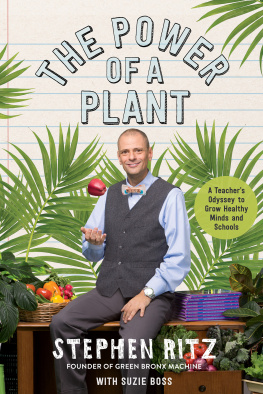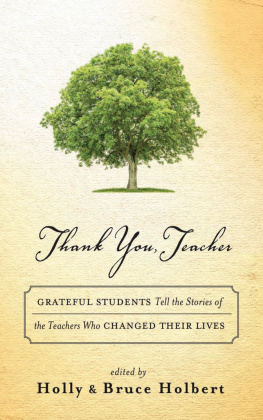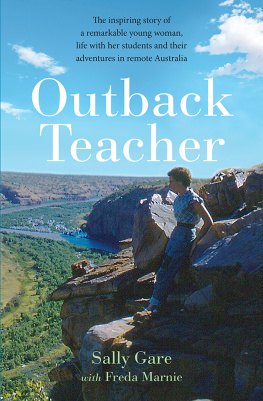Teaching Peace
Also by Colman McCarthy
Disturbers of the Peace: Profiles in Nonadjustment (1973)
Inner Companions (1975)
The Pleasures of the Game: The Theory Free Guide to Golf (1977)
Involvements: One Journalists Place in the World (1984)
All of One Peace: Essays in Nonviolence (1994)
Solutions to Violence (Editor, 2001)
Strength through Peace: The Ideas and People of Nonviolence (Editor, 2001)
Id Rather Teach Peace (2002)
At Rest With the Animals: Thoughts Over Thirty Years (2008)
Peace Is Possible (Editor, 2012)
Baseball Forever (2014)

Teaching Peace
Students Exchange Letters with Their Teacher
Colman McCarthy
VANDERBILT UNIVERSITY PRESS
Nashville
2015 by Vanderbilt University Press
Nashville, Tennessee 37235
All rights reserved
First printing 2015
This book is printed on acid-free paper.
Manufactured in the United States of America
Library of Congress Cataloging-in-Publication Data on file
LC control number 2014019563
LC classification number JZ5534.M44 2015
Dewey class number 303.66071dc23
ISBN 978-0-8265-2038-8 (hardcover)
ISBN 978-0-8265-2039-5 (paperback)
ISBN 978-0-8265-2040-1 (ebook)
To my students, from Ariel to Yurina, whose words grace these pages. And, of course, to Mav McCarthy
Contents
by Patrick G. Coy
Acknowledgments
I owe some debts, both to those who have supported the Center for Teaching Peace, which my wife, Mav, and I founded in 1985, and to those whose friendship was a tailwind that helped make the going easier and the loads lighter.
Special and large thanks to the Helen Sperry Lea Foundation, the Olender Foundation, the Florence and John Schumann Foundation, the Nicholas B. Ottaway Foundation, the Morris and Gwendolyn Cafritz Foundation, Liz Wenger, Paul and Annie Mahon, the Nuclear Age Peace Foundation, the Barbra Streisand Foundation, the El-Hibri Charitable Foundation, the Penny and Ray Watts Trust, the National Student Leadership Foundation, the Lubsen Family Charitable Gift Fund, the Washington Post Company, the Public Welfare Foundation, the Lichtman Family Trust, Jim Monahan, Susan See, Grace Kelly, Morton Mintz, Nathaniel Mills, Katherine Hessler, John Storhm, Linda Smith, John Vincent, Kate Christianson, Joe and Joanne Steller, James Otis, Tara Foran, Charles Stevenson, Ayiesha Alizai Sadik, Maryanne Burke, Arthur Milholland, James Allen, Joanne Kim, Bernard Demczuk, Beth Blacklow, Eleftherios Michael, Joan Baez, Tommy Boone, Maria Shriver, Keith Sinzinger, Claire Nader, Ralph Nader, Kersti Columbant, Geri Critchley, Rep. Marci Kaptur, Claudia Levy, Barbara Zimmerman, Ruth Sherer, and many others of spirited nature.
Foreword
Patrick G. Coy
I have come to think of this creative and inspirational book as emblematic of Colman McCarthys lived experiment with truthful teaching. Let me explain.
Gandhi titled his autobiography My Experiments with Truth in part because he knew he could never fashion a perfect mixture of heart-felt principles lived out in behavioral practices resulting in a truth-filled life. All he could hope for was to purposefully keep on experimenting each day to live out values-based principles in the face of constantly changing daily challenges. Those daily experiments not only were rooted in humility and a willingness to learn; they also required a self-reflexive spirit manifested in Gandhis disciplined note-taking and journal writing (500 words almost every day from his law school days onward), which became the basis not only of his autobiography but also of his bountiful essays and articles.
Some of Gandhis daily experiments were marked by failure. Other daysthe good oneshis experiments might be deemed a partial success, but never more. The important thing to him was to stay committed to the daily experiments in truth and to never succumb to the false notion that he had achieved a truth-filled life. This was no easy feat considering the throngs nearby and worldwide who extolled his greatness, even his holiness. Yet Gandhi still managed to see each day as an experiment, to accept the encounters it presented as opportunities to grow toward the truth and to approximate it in some way.
Sadly, such an approach does not square well with the American spirit; it conflicts with entrenched national attitudes. That is why I often think of Gandhis experiments with truth whenever one of my students mimes the tantalizing trope that the United States is the greatest country and the best democracy the world has ever seen. Weve all heard this hegemonic maxim many, many times; it is often presented as a taken-for-granted expression of US reality.
But that notion is little more than the teat of the empire, the milk that every American school student suckles on from first grade through high school or risks going hungry and becoming a dissenting outsider. It is an attitude that slams the door shut on doubt, keeping humility at bay while allowing vainglory and the presumptuousness of empire in through every nook and cranny of the public house. If we have the greatest democracy ever and if we keep reminding ourselves of this so-called fact then that is the end of the story. Worse still, it is also the end of our daily experiments with improving democracy. We risk making democracy pro forma, only aping the tired motions rather than actually experimenting with new approaches to democracy and therefore embracing different results.
An admirer and serious student of Gandhi, McCarthy rejects this imperial presumptuousness both as a citizen and as teacher. He embraces each day and each class session as another opportunity to experiment in truth-seeking about democracy and its relations to peace and violence with his colleagueshis students. He not only gives them permission to be dissenting outsiders, he encourages it, presenting dissent as part of their experiments in acquiring knowledge through developing their own truths.
These are heartfelt letters from his students, often written in direct response to some provocative pedagogical tactic McCarthy deployed in a class session to invite his students into experimenting with truth. What makes these exchanges so fascinating and keeps us reading is that the letter-writers probe and poke at their teacher in the same ways that he no doubt probed and poked at the unexamined dimensions of their lives.
For example, in one of these fascinating exchanges, a student is puzzling over voting in elections and wants McCarthy to better explain his position because she was initially outraged that he did not vote. McCarthys letter in response shows him to be not only a dissenter living out a daily experiment with the meanings of democracy but a patient and inspiring teacher in the classroom and beyond:
People who vote are placing their faith in politicians who believe in violent solutions to conflicts. As a pacifist, it is only in political elections that I decline to vote. I vote every day to get up at 6 am to teach my high school classes, I vote every day to buy healthy and cruelty-free food. I vote every day to commute by bicycle. I vote every day to spend time with my family. I vote every day to buy products that do no harm to the environment. To my mind, that is true voting poweroccurring every daythat has nothing to do with electoral politics that involves passively pulling a lever once every four years.
This book about teaching is just as much about extending teaching beyond the classroom through letter writing. It works well because of the variety of approaches and tones that McCarthy takes in his responses to the letters from his students. Some of McCarthys letters are witty and sharp, and he seems to have the knack of his Irish ancestors for using just the right amount of sarcasm, something that is too easily and too often overdone in hands less deft than his. In some letters he embraces the mentor role and guides the student into a deeper analysis through some engaging story. Elsewhere McCarthy seems more like a compassionate colleague, reciprocating the students vulnerability by taking them into his confidence and relating his own struggles, his own daily experiments. In other letters he stands in solidarity with a moral choice a student has made, signaling the encouragement and support they seem to seek from their former teacher in order to live out a critical and ultimately dissenting life within the American experiment with democracy.
Next page






